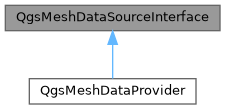Interface for mesh data sources. More...
#include <qgsmeshdataprovider.h>

Public Member Functions | |
| virtual | ~QgsMeshDataSourceInterface ()=default |
| bool | contains (const QgsMesh::ElementType &type) const |
| Returns whether the mesh contains at mesh elements of given type. | |
| virtual int | edgeCount () const =0 |
| Returns number of edges in the native mesh. | |
| virtual int | faceCount () const =0 |
| Returns number of faces in the native mesh. | |
| virtual int | maximumVerticesCountPerFace () const |
| Returns the maximum number of vertices per face supported by the current mesh, if returns 0, the number of vertices is unlimited. | |
| virtual void | populateMesh (QgsMesh *mesh) const =0 |
| Populates the mesh vertices, edges and faces. | |
| virtual bool | saveMeshFrame (const QgsMesh &mesh)=0 |
| Saves the mesh frame to the source. | |
| virtual int | vertexCount () const =0 |
| Returns number of vertices in the native mesh. | |
Detailed Description
Interface for mesh data sources.
Mesh is a collection of vertices, edges and faces in 2D or 3D space
- vertex - XY(Z) point (in the mesh's coordinate reference system)
- edge - two XY(Z) points (in the mesh's coordinate reference system) representing straight seqment
- faces - sets of vertices forming a closed shape - typically triangles or quadrilaterals
Base on the underlying data provider/format, whole mesh is either stored in memory or read on demand
- Note
- The API is considered EXPERIMENTAL and can be changed without a notice
- Since
- QGIS 3.2
Definition at line 131 of file qgsmeshdataprovider.h.
Constructor & Destructor Documentation
◆ ~QgsMeshDataSourceInterface()
|
virtualdefault |
Member Function Documentation
◆ contains()
| bool QgsMeshDataSourceInterface::contains | ( | const QgsMesh::ElementType & | type | ) | const |
Returns whether the mesh contains at mesh elements of given type.
- Since
- QGIS 3.14
Definition at line 227 of file qgsmeshdataprovider.cpp.
◆ edgeCount()
|
pure virtual |
Returns number of edges in the native mesh.
- Returns
- Number of edges in the mesh
- Since
- QGIS 3.14
◆ faceCount()
|
pure virtual |
Returns number of faces in the native mesh.
- Returns
- Number of faces in the mesh
◆ maximumVerticesCountPerFace()
|
inlinevirtual |
Returns the maximum number of vertices per face supported by the current mesh, if returns 0, the number of vertices is unlimited.
- Returns
- Maximum number of vertices per face
- Since
- QGIS 3.22
Definition at line 171 of file qgsmeshdataprovider.h.
◆ populateMesh()
|
pure virtual |
Populates the mesh vertices, edges and faces.
- Since
- QGIS 3.6
◆ saveMeshFrame()
|
pure virtual |
Saves the mesh frame to the source.
- Parameters
-
mesh the mesh to save
- Returns
trueon success
- Since
- QGIS 3.22
◆ vertexCount()
|
pure virtual |
Returns number of vertices in the native mesh.
- Returns
- Number of vertices in the mesh
The documentation for this class was generated from the following files:
- /build/qgis-3.99.0+git20250718+f78f5286a64+99sid/src/core/mesh/qgsmeshdataprovider.h
- /build/qgis-3.99.0+git20250718+f78f5286a64+99sid/src/core/mesh/qgsmeshdataprovider.cpp